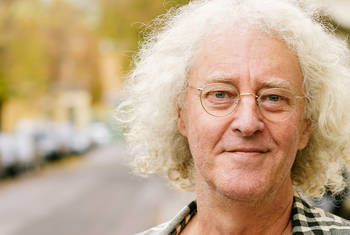Bill S. Hansson How Do Insects Use Their Sense of Smell and How Does It Function?
Bill S. Hansson is Vice President of the Max Planck Society and Director of the Department of Evolutionary Neuroethology at the Max Planck Institute for Chemical Ecology in Jena, Germany. Furthermore, he is a guest professor and partner in the ICE3 Linnaeus research program at The Swedish University for Agricultural Sciences in Alnarp. Hansson focuses his research on neurophysiological and behavioral aspects of insect-insect and insect-plant interactions where he takes a special interest in insect olfaction. Bill Hansson is a fellow of several national and international science academies, such as the Royal Swedish Academy of Sciences and the Academia Europaea, and an Honorary Professor at Friedrich Schiller University Jena.
Area of Research
Evolutionary Neuroethology
since 2014
Vice President
Max Planck Society (more details)
since 2006
since 2006
Guest Professor, Scientific Leader (until 2010) and Partner in the ICE3 Linnaeus Research Program
Swedish University of Agricultural Sciences
since 2000
Promoted Professor
Lund University
Chemical Ecology
2011-2014
2003-2006
Associate Dean
Swedish University of Agricultural Sciences
Faculty for Landscape Planning Horticulture and Agricultural Sciences
2001-2006
Professor and Head of Chemical Ecology
Swedish University of Agricultural Sciences
1995-2001
Associate Professor
Lund University
Neurobiology
1992-1992
Associate Professor
Lund University
1990-1995
Assistant Professor
Lund University
1989-1990
Post-Doctoral Research Associate
University of Arizona
Division of Neurobiology
1988
PhD in Ecology
Lund University
1982
Bachelor in Biology
Lund University
- Behavioural Ecology
- Behaviour and Evolution
- Brain
- Cell
- Cell and Tissue Research
- Chemical Senses
- Chemoecology
- Current Biology
- Entomologia experimentalis et applicata
- Functional Ecology
- Genomics
- Insect Biochemistry and Molecular Biology
- Journal of Chemical Ecology
- Journal of Comparative Neurology
- Journal of Comparative Physiology A
- Journal of Entomological Science
- Journal of Experimental Biology
- Journal of Insect Physiology
- Journal of Neurobiology
- International Journal of Tropical Insect Science
- Molecular and Cellular Neuroscience
- Nature
- Nature Communications
- Neuron
- Neuroscience Letters
- Neuroscience Methods
- Oikos
- Physiological Entomology
- Plant Biology
- PLoSONE
- PLoS Genetics
- The European Journal for Biochemistry
- The Italian Journal of Zoology
- Trends in Plant Science
- Trends in Genetics
- Association for Chemoreception Sciences (AchemS)
- European Chemoreception Research Organisation (ECRO)
- European Symposium on Insect Taste and Olfaction (ESITO)
- International Society for Chemical Ecology (ISCE)
- Leaders in Higher Research Organisations (HIROs)
Prizes
- The ISCE Silverstein-Simeone Lecture Award (2014)
- BingZhi Professorship of the Chinese Academy of Sciences, Zoology (2013)
- The AChemS Givaudan Lecture Award (2013)
- The Royal Swedish Academy of Science Letterstedt Prize (2009)
- The Belgian Royal Academy of Sciences JM Delwart Award in Chemical Communication (2000)
- The Takasago International Research Award in Olfactory Science (1998)
Fellowships
- The Royal Entomological Society (FRES; Honorary)
- The Royal Swedish Academy of Sciences (KVA)
- The Royal Swedish Academy of Agriculture and Forestry (KSLA)
- The Royal Physiographic Society in Lund, Sweden
- The Saxonian Academy of Science in Leipzig, Germany
- Academia Europaea
- The Finnish Society of Sciences and Letters
- The Wenner Gren Foundation: Optical Imaging
- NFR: From Molecule to Mind
- EU, Marie Curie Grant: Evolution of Olfactory Coding
- NFR: From Molecule to Mind
- SJFR: Flexibility in Host Choice in Insects
- Carl Tryggers Stiftelse: Molekylär igenkänning i bananflugans perifera doftsinne
- STINT: The Evolution of Insect Olfaction
- VR: Olfactory Detection, Processing and Evolution
- EU – IST: A Fleet of Artificial Chemosensing Moths
- Formas: Flexibility in Host Choice in Insects
- VR: 3rd International Symposium on Insect Pheromones
- VR: Confocal Microscope
- Formas: 3rd International Symposium on Insect Pheromones
- Gyllenstiernska Krapperupstiftelsen: Olfactory Evolution
- VR: Olfaction – Structure, Function and Evolution
- Sida/Sarec: Efficient and Environmentally Sustainable Control of Sorghum Chafer, Pachnoda Marginata, by Mass Trappin
- Formas: The Odor World of the Mosquito – Function and Manipulation
- Formas: Bovine Pheromones
- Formas: Semiochemical Diversity and Insect Dynamics
- The Linnaeus Initiative: Insect Chemical Ecology, Ethology and Evolution
- Sida/Sarec: Efficient and Environmentally Sustainable Control of Sorghum Chafer, Pachnoda Marginata, by Mass Trapping
- EU: Artificial Infochemical Communication
- DFG: Schwerpunkt Olfaktion
- Volkswagenstiftung: Evolution of the Arthropod Olfactory System
- VR: ISOT16
- Formas: ISOT16
- Volkswagenstiftung: Insect Chemical Ecology
- Deutsche Forschungsgemeinschaft: An Integrative Analysis of the Olfactory System in Terrestrial vs. Marine Hermit Crabs
- EU Horizon 2020 FET: NanoSmell
 © Maximilian Dörrbecker
© Maximilian Dörrbecker
Max Planck Society
"The Max Planck Society is Germany's most successful research organization. Since its establishment in 1948, no fewer than 18 Nobel laureates have emerged from the ranks of its scientists, putting it on a par with the best and most prestigious research institutions worldwide. The more than 15,000 publications each year in internationally renowned scientific journals are proof of the outstanding research work conducted at Max Planck Institutes – and many of those articles are among the most-cited publications in the relevant field." (Source)
Institute
Max Planck Institute for Chemical Ecology
"The Max Planck Institute for Chemical Ecology in Jena investigates the role, diversity and characteristics of chemical signals which control the interactions between organisms and their environment. Scientists from the fields of ecology, biochemistry, organic chemistry, entomology, ethology, and insect physiology work closely together in the Institute in order to understand the complex system of chemical communication. Their research focuses on the co-evolution of plants and insects. The fact that plants usually spend their entire lives in one place forces them to use effective strategies to guarantee that their offspring are spread and also to protect themselves against pests and diseases. To this effect, plants have developed a wide range of chemical signalling compounds that enable them to optimise their adaptation to their respective environments. These so-called allelochemicals are used to, among other things, attract pollinators, fend off herbivores and pests, fight diseases and keep unwelcome competitors away. Plants also synthesise mixtures of many organic substances that have a deterrent or toxic effect on herbivores. As a countermeasure, insects that feed on plants adapt accordingly and, for their part, try to overcome plant defences." (Source)
Map
Insects are very smell-dependent which makes them prime candidates for studying how the sense of smell works and how it influences behavior. In this video, BILL S. HANSSON describes how the research team studied the olfactory system of flies. Following the whole process from molecule detection and the reaction of the nerves to the outcome of behavior the researchers found a line in the fly's brain that identifies bad odors and leads the fly to avoid these smells as they indicate something is toxic. Because the olfactory systems of all species work in a similar way, the findings can be used to draw conclusions to the human sense of smell.
LT Video Publication DOI: https://doi.org/10.21036/LTPUB10198
A Conserved Dedicated Olfactory Circuit for Detecting Harmful Microbes in Drosophila
- Marcus C. Stensmyr, Hany K.M. Dweck, Abu Farhan, Irene Ibba, Antonia Strutz, Latha Mukunda, Jeanine Linz, Veit Grabe, Kathrin Steck, Sofia Lavista-Llanos, Dieter Wicher, Silke Sachse, Markus Knaden et al
- Cell
- Published in 2012









